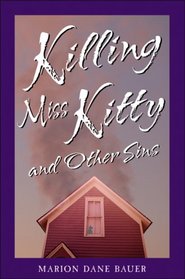Reviewed by Natalie Tsang for TeensReadToo.com
You would think that reading about other people's sins wouldn't be much fun, but Marion Dane Bauer's KILLING MISS KITTY AND OTHER SINS is a surprisingly pleasant and quick read. Set in the 1950s, we follow Claire, a young girl growing up in a small town in Illinois, through five stories spread out over about five years.
One of my few complaints is that at only 167 pages, including the foreword and afterword, the book is much too short. The five stories offer just a glimpse of Claire, a thoughtful but woefully awkward girl. I think that the author is great at illustrating Claire's charmingly adolescent need to define who she is yet her inability and lack of desire to understand anyone else. Only belatedly and temporarily does Claire see beyond her own little world. It's refreshing that Marion Dane Bauer's characters consistently put self-preservation before doing the right thing but have enough of a conscience to feel guilty, at least briefly, each time.
My favorite story is KILLING MISS KITTY. It will be hard for me to tell what's so great about this story without giving away the plot. This is the only story that is centered around family. This is also one of Claire's most imagined stories because she isn't actually a witness to a lot of the events that she recounts. It's ironic that the story in which her mother and her brother become most life-like is also the least "true." Because Claire is not there, it gives her enough objectivity to see her mother and brother as people instead of obstacles and the occasional aid.
KILLING MISS KITTY AND OTHER SINS is definitely not a novel, but the five stories are so interrelated that calling it an anthology or a short story collection would be a betrayal of its cohesive nature. Sometimes it seems as if the contents are lifted from the pages of Claire's journal. A journal that is both extremely private yet also begging to be read and understood.
Overall, Bauer paints a convincing portrait of adolescence that doesn't illuminate but points out and occasionally pokes fun at the trials and tribulations in the inevitable stumble towards growing up.
You would think that reading about other people's sins wouldn't be much fun, but Marion Dane Bauer's KILLING MISS KITTY AND OTHER SINS is a surprisingly pleasant and quick read. Set in the 1950s, we follow Claire, a young girl growing up in a small town in Illinois, through five stories spread out over about five years.
One of my few complaints is that at only 167 pages, including the foreword and afterword, the book is much too short. The five stories offer just a glimpse of Claire, a thoughtful but woefully awkward girl. I think that the author is great at illustrating Claire's charmingly adolescent need to define who she is yet her inability and lack of desire to understand anyone else. Only belatedly and temporarily does Claire see beyond her own little world. It's refreshing that Marion Dane Bauer's characters consistently put self-preservation before doing the right thing but have enough of a conscience to feel guilty, at least briefly, each time.
My favorite story is KILLING MISS KITTY. It will be hard for me to tell what's so great about this story without giving away the plot. This is the only story that is centered around family. This is also one of Claire's most imagined stories because she isn't actually a witness to a lot of the events that she recounts. It's ironic that the story in which her mother and her brother become most life-like is also the least "true." Because Claire is not there, it gives her enough objectivity to see her mother and brother as people instead of obstacles and the occasional aid.
KILLING MISS KITTY AND OTHER SINS is definitely not a novel, but the five stories are so interrelated that calling it an anthology or a short story collection would be a betrayal of its cohesive nature. Sometimes it seems as if the contents are lifted from the pages of Claire's journal. A journal that is both extremely private yet also begging to be read and understood.
Overall, Bauer paints a convincing portrait of adolescence that doesn't illuminate but points out and occasionally pokes fun at the trials and tribulations in the inevitable stumble towards growing up.





